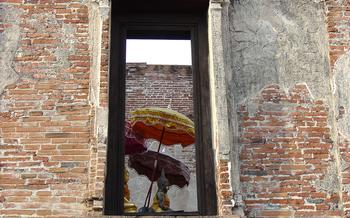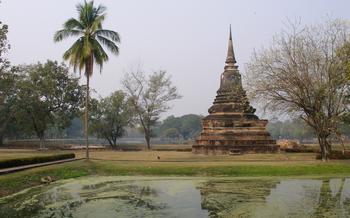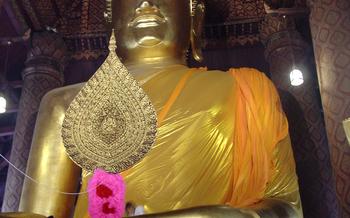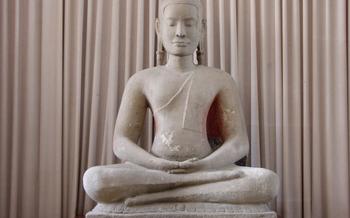
Wat Ban Yang
- Wat Ban Yang: A Monkey-Filled Temple in Lopburi
- Exploring the Temple Grounds
- Interacting with the Monkeys
- The Monkey Buffet Festival
- Other Attractions in Lopburi
- Getting to Wat Ban Yang
- Best Time to Visit Wat Ban Yang
- Where to Stay in Lopburi
- What to Eat in Lopburi
- Shopping in Lopburi
- Cultural Etiquette and Customs
- Health and Safety Tips
- Additional Tips for a Great Experience
- Insider Tip: Hidden Monkey Spot
Wat Ban Yang: A Monkey-Filled Temple in Lopburi
In the heart of Thailand's Lopburi province lies a remarkable temple known as Wat Ban Yang. This ancient site has gained global fame for its unique inhabitants – a large population of playful and mischievous monkeys. While the exact origins of the temple remain shrouded in mystery, it is believed to date back to the Ayutthaya period (1350-1767). Over the centuries, Wat Ban Yang has evolved into a sanctuary for both primates and pilgrims, offering visitors an unforgettable experience of cultural heritage and wildlife interaction.
The temple's most striking feature is its intricate architecture, which seamlessly blends traditional Thai elements with natural surroundings. Visitors are greeted by a majestic chedi (stupa), adorned with colorful tiles and intricate carvings, which stands as a testament to the craftsmanship of its builders. The temple grounds are dotted with numerous viharns (assembly halls) and Buddha images, each with its own unique story to tell.
However, the true stars of Wat Ban Yang are undoubtedly the monkeys. These clever and agile creatures roam freely within the temple compound, providing endless entertainment for visitors. Their antics range from playful wrestling matches to acrobatic displays, and they are always eager to interact with curious onlookers.
Exploring the Temple Grounds
Wat Ban Yang is a fascinating blend of ancient architecture and natural beauty. The temple complex is divided into several sections, including the main temple building, a courtyard, a stupa, and a pond. The main temple building is a traditional Thai structure with a colorful exterior and intricate carvings. Inside the temple, you'll find a large Buddha image, as well as several smaller Buddha statues and other religious artifacts.
The courtyard is a spacious area surrounded by trees and flowers. It's a popular spot for visitors to relax and take in the scenery. The stupa is a large, bell-shaped structure that is located in the center of the complex. It's a sacred place for Buddhists, and visitors are asked to show respect by not climbing on it or touching it. The pond is a small, artificial body of water that is home to a variety of fish and turtles. It's a peaceful spot to sit and enjoy the sounds of nature.
In addition to the main temple building, courtyard, stupa, and pond, Wat Ban Yang also has a number of other notable structures and landmarks. These include a library, a museum, and a bell tower. The library contains a collection of ancient Buddhist texts and manuscripts. The museum displays artifacts related to the history of the temple and the local area. The bell tower is a tall, slender structure that houses a large bronze bell. Visitors are allowed to climb to the top of the tower for a panoramic view of the temple complex and the surrounding area.
Interacting with the Monkeys
A Visit to Wat Ban Yang Offers a Once-in-a-Lifetime Opportunity to Interact with Monkeys in a Unique and Natural Setting.
Before venturing into the temple grounds, it's important to familiarize yourself with proper etiquette to ensure a safe and enjoyable experience. Follow these guidelines:
-
Maintain a Respectful Distance: Approach the monkeys calmly and keep a safe distance to avoid startling them.
-
Avoid Direct Eye Contact: Monkeys may perceive direct eye contact as a challenge, so avert your gaze to show respect.
-
Never Feed the Monkeys Human Food: Feeding them unhealthy snacks can cause health problems. Stick to the bananas and peanuts provided by the temple.
-
Be Cautious with Your Belongings: Monkeys are curious and may attempt to snatch items like sunglasses, hats, or food. Keep your valuables secure.
Engaging with the Monkeys:
-
Observe Their Behavior: Watch the monkeys interact with each other and with visitors. Their playful antics and social dynamics are fascinating to observe.
-
Offer Food Cautiously: If you wish to feed the monkeys, hold the food out slowly and let them approach you. Never force-feed them.
-
Respect Their Space: If a monkey shows signs of discomfort or aggression, back away slowly and give it space.
-
Capture Memorable Moments: Take photos and videos, but be mindful of the monkeys' comfort. Avoid using flash photography, as it can startle them.
Monkey Behaviors to Watch Out for:
-
Tail Flicking: A flicking tail indicates annoyance or agitation.
-
Lip Smacking: This sound is a warning sign that a monkey may be about to bite.
-
Teeth Baring: A clear sign of aggression. Back away slowly and avoid any further interaction.
-
Screaming: Monkeys scream to communicate danger or distress. If you hear screaming, leave the area immediately.
The Monkey Buffet Festival
Origin and History: The Monkey Buffet Festival, also known as the "Monkey Banquet," is a unique and iconic event held annually at Wat Ban Yang. The festival originated in 1989 as a way to honor and appease the temple's monkey population. The event has since gained international recognition and attracts thousands of visitors each year.
Preparations and Logistics: In the weeks leading up to the festival, the temple grounds are transformed into a feast fit for royalty. Tons of fresh fruits, vegetables, and other treats are carefully arranged on long tables and platforms. The food is donated by local businesses, farmers, and individuals who wish to participate in this grand celebration.
Festivities and Highlights: The festival typically takes place over several days, culminating in a grand buffet on the final day. On this day, the monkeys are invited to partake in a lavish feast, while visitors can observe the spectacle from designated viewing areas. The monkeys descend upon the tables, indulging in a smorgasbord of delicious offerings.
Tips for Attending the Festival: - Arrive early to secure a good spot and avoid the crowds. - Dress comfortably and in light-colored clothing. - Bring a camera to capture the unique and amusing moments. - Be respectful of the monkeys and their behavior. - Do not feed the monkeys directly or offer them any food that is not part of the festival buffet.
Other Attractions in Lopburi
Historical Sites and Landmarks
In addition to Wat Ban Yang, Lopburi is home to a wealth of historical sites and landmarks. The city's ancient past can be traced back to the Dvaravati period, and many ruins and artifacts from this era can still be seen today. One of the most notable historical sites is Phra Prang Sam Yot, a 13th-century temple complex that is one of the most iconic landmarks in Lopburi. The complex consists of three prangs, or towers, which are adorned with intricate carvings and sculptures. Another must-see historical site is the Narai Ratchaniwet Palace, which was built by King Narai the Great in the 17th century. The palace is a beautiful example of traditional Thai architecture and features a variety of pavilions, halls, and gardens.
Museums and Cultural Venues
Lopburi is also home to several museums and cultural venues that offer visitors a glimpse into the city's rich history and culture. The Lopburi Museum is a great place to learn about the city's past and features a variety of exhibits on local history, archaeology, and culture. The Lopburi National Museum is another must-see for history buffs, and it houses a collection of artifacts from the Dvaravati, Ayutthaya, and Rattanakosin periods. For those interested in learning more about the city's contemporary culture, the Lopburi Art Center is a great place to visit. The center hosts a variety of exhibitions, workshops, and performances throughout the year.
Natural Attractions and Parks
Lopburi is also home to a number of natural attractions and parks. The Khao Sam Lan National Park is a popular destination for hiking, biking, and camping. The park is home to a variety of wildlife, including monkeys, birds, and reptiles. The Pa Sak Jolasid Dam is another popular spot for outdoor recreation, and it offers a variety of activities such as boating, fishing, and swimming.
Recommended Day Trips from Lopburi
Lopburi is a great base for exploring the surrounding area. There are a number of interesting day trips that can be taken from the city, including a visit to the ancient city of Ayutthaya, the Bang Pa-In Royal Palace, and the Khao Yai National Park.
Getting to Wat Ban Yang
Transportation Options from Bangkok and Other Cities
Wat Ban Yang is conveniently located just a short distance from Bangkok, the capital of Thailand. From Bangkok, you can easily reach Lopburi by train, bus, or car. The train journey takes approximately 2 hours and costs around 100 baht (less than $3). Buses are slightly cheaper, but the journey takes a bit longer at around 3 hours. If you prefer the freedom and flexibility of your own vehicle, you can rent a car or hire a driver for the day trip to Lopburi. The drive takes about 1 hour and 30 minutes from Bangkok.
Public Transportation within Lopburi
Once in Lopburi, you can take a tuk-tuk or songthaew (shared taxi) to Wat Ban Yang. Tuk-tuks typically charge around 50-100 baht for a short ride within the city, while songthaews cost around 20-30 baht per person. You can also choose to walk to the temple, which takes about 20-30 minutes from the city center.
Renting a Car or Hiring a Driver
If you prefer the convenience of having your own transportation, you can rent a car or hire a driver for the day. Car rental rates in Lopburi start at around 500 baht per day, while hiring a driver with a car will cost around 1,000 baht per day. This can be a great option if you want to explore other attractions in Lopburi province, such as the historical ruins of Ayutthaya or the Khao Yai National Park.
Parking and Accessibility
Wat Ban Yang has a small parking lot that can accommodate a limited number of cars and tour buses. Parking is free of charge, but it can be challenging to find a spot during peak tourist season. The temple is wheelchair accessible, with ramps and elevators providing access to all areas of the complex.
Best Time to Visit Wat Ban Yang
The best time to visit Wat Ban Yang is during the dry season, which runs from November to April. During this period, the weather is generally pleasant, with cool nights and warm days. The skies are clear, making it ideal for taking stunning photos of the temple and the monkeys.
The peak tourist season in Lopburi is from December to February, when the weather is at its best. However, this also means that the temple can be crowded, especially during weekends and holidays. If you prefer a quieter experience, consider visiting during the shoulder months of November, March, or April.
Special events such as the Monkey Buffet Festival and the Lopburi Monkey Fair attract large crowds, so it's best to plan your visit accordingly. If you're interested in attending these events, book your accommodation and transportation in advance.
The recommended time of day to visit Wat Ban Yang is early in the morning or late in the afternoon, when the temperatures are cooler, and the monkeys are most active. The morning light is also ideal for photography. Avoid visiting during the midday heat, as the monkeys tend to be less active and may seek shelter from the sun.
Where to Stay in Lopburi
When planning your trip to Wat Ban Yang, choosing the right accommodation in Lopburi is essential for a comfortable and enjoyable stay. The city offers a range of options to suit different budgets and preferences, whether you're a backpacker looking for a budget-friendly guesthouse or a luxury traveler seeking a pampering experience.
For those who want to be close to the temple, several guesthouses and budget hotels are located within walking distance of Wat Ban Yang. These accommodations typically offer basic but clean rooms at affordable prices.
If you're looking for a more comfortable stay, mid-range hotels and resorts are available in Lopburi, offering amenities like swimming pools, fitness centers, and restaurants. These hotels are often located in the city center, providing easy access to other attractions and amenities.
For a truly unforgettable experience, consider splurging on a stay at one of Lopburi's luxury accommodations or boutique hotels. These establishments offer elegant rooms, personalized service, and stunning views of the city or the surrounding countryside.
No matter your budget or preferences, you're sure to find the perfect place to stay in Lopburi that will make your visit to Wat Ban Yang and the city a memorable one.
What to Eat in Lopburi
When in Lopburi, don't miss the chance to savor the local cuisine. The city offers a delightful mix of traditional Thai dishes and unique regional specialties.
Must-Try Delicacies:
-
Boat Noodles (Kuay Tiew Ruea): These flavorful noodle soups are a local favorite. Vendors sell them from boats along the Lopburi River, creating a unique dining experience.
-
Lopburi Satay (Moo Satay): Succulent grilled pork skewers marinated in a special sauce that's a local secret.
-
Khao Niao Mamuang (Sticky Rice with Mango): A classic Thai dessert featuring sweet, ripe mangoes served with glutinous rice.
Recommended Restaurants:
- For Authentic Thai Cuisine:
-
Ruean Thai Cuisine: A family-run restaurant serving traditional Thai dishes in a cozy setting.
-
For Street Food:
-
Lopburi Night Market: A lively market with a wide variety of street food stalls, including local delicacies and international fare.
-
For Vegetarian and Vegan Options:
- Veggie Planet: A vegetarian restaurant offering a range of healthy and delicious dishes.
Tips for Trying Exotic Dishes:
-
Be Adventurous: Don't shy away from trying new dishes, even if they seem unusual.
-
Ask Locals for Recommendations: Locals often know the best places to find authentic and delicious food.
-
Be Prepared for Strong Flavors: Thai cuisine is known for its bold flavors, so be prepared for dishes that may be spicy or have unique flavor combinations.
Shopping in Lopburi
Lopburi offers a vibrant shopping scene, where you can find a treasure trove of local handicrafts, souvenirs, and unique items.
-
Local Markets and Bazaars: Immerse yourself in the bustling atmosphere of local markets like the Thung Pho Market or the Wang Muang Market. Here, you can find everything from fresh produce and spices to handmade crafts and clothing. Don't forget to haggle for the best prices!
-
Handicrafts and Souvenirs: Lopburi is renowned for its intricate handicrafts, such as wood carvings, pottery, and woven textiles. Visit the Khao Sam Roi Yot National Park for a chance to witness artisans at work and purchase their beautiful creations.
-
Bargaining Tips and Tricks: Bargaining is a common practice in Thailand, and Lopburi is no exception. Be prepared to negotiate prices, but do so respectfully and with a smile. Start by offering around half of the asking price and gradually increase your offer as needed.
-
Ethical Shopping Practices: When shopping in Lopburi, remember to support ethical and sustainable businesses. Look for shops that use eco-friendly materials and fair trade practices. By doing so, you can help preserve local traditions while making a positive impact on the community.
Cultural Etiquette and Customs
Dress Code and Appropriate Attire: Embrace modest dressing when visiting religious sites or temples. Avoid revealing or overly casual clothing such as shorts, tank tops, or flip-flops. Opt for lightweight, loose-fitting attire that covers your shoulders and knees.
Respecting Local Traditions and Beliefs: Be mindful of local customs and traditions, particularly in sacred spaces. Remove your shoes before entering temples, and refrain from pointing your feet towards Buddha images or monks. When encountering monks, greet them with a respectful "wai" (a slight bow with your hands pressed together in a prayer-like gesture).
Tipping Customs and Guidelines: Tipping is not customary in Thailand, and it is generally not expected in most situations. However, if you receive exceptional service at a restaurant or from a tour guide, a small tip is appreciated.
Communicating with Locals: While English is widely spoken in tourist areas, learning a few basic Thai phrases can go a long way in showing respect and making connections with locals. "Sawasdee" (hello) and "khob khun krab/kha" (thank you) are essential greetings.
Health and Safety Tips
Vaccinations and health precautions: Before traveling to Thailand, ensure you are up-to-date on routine vaccinations, such as measles, mumps, rubella (MMR), and tetanus. Consider getting vaccinated against hepatitis A and typhoid if you plan to eat street food or stay in budget accommodations.
Avoiding scams and tourist traps: Lopburi is generally a safe city, but it's essential to be aware of common scams. Be wary of tuk-tuk drivers who offer overpriced tours or take you to their friends' shops. Avoid unsolicited services like massage parlors or gem stores, and only exchange currency at authorized money changers.
Personal safety measures: While the monkeys are generally friendly, it's crucial to take precautions to avoid bites or scratches. Don't make sudden movements or stare directly into their eyes. Keep your distance and never try to touch or feed them. Be aware of your surroundings and avoid walking alone at night.
Emergency contacts and resources: In case of an emergency, dial 191 for the police, 1669 for the tourist police, or 1155 for medical assistance. Keep a copy of your passport and travel insurance information with you at all times.
Additional Tips for a Great Experience
To make your visit to Wat Ban Yang even more enjoyable, consider these additional tips:
-
Pack essentials and comfortable clothing: Wear light and airy clothing that you don't mind getting dirty, as the monkeys may jump on you or swing from your clothes. Also, bring a hat, sunglasses, and sunscreen to protect yourself from the sun.
-
Bring a camera and extra batteries: Wat Ban Yang is a photographer's paradise, so make sure to bring your camera and extra batteries to capture all the unique moments.
-
Learn a few basic Thai phrases: While most locals in the tourist areas speak some English, learning a few basic Thai phrases can go a long way in showing respect for the culture and making it easier to communicate with locals.
-
Stay hydrated and wear sunscreen: The weather in Lopburi can be hot and humid, so make sure to stay hydrated by drinking plenty of water. Also, wear sunscreen to protect your skin from the sun's harmful rays.
Insider Tip: Hidden Monkey Spot
Amidst the bustling temple grounds, there lies a hidden gem known only to a select few. Nestled amidst the lush foliage, a secluded viewpoint offers a unique perspective on the monkey's antics. From this vantage point, you can observe their playful interactions, curious expressions, and intimate moments without disturbing their natural habitat.
To find this secret spot, venture towards the northwestern corner of the temple complex. As you approach a towering banyan tree, look for a narrow path that leads into the foliage. Follow the winding trail, keeping an eye out for monkeys swinging from the branches above. The path will eventually lead you to a clearing, revealing a panoramic view of the monkey colony.
The best time to visit this hidden spot is early in the morning or late in the afternoon, when the monkeys are most active. As the sun casts a golden glow upon the temple grounds, you'll witness a symphony of colors and movements as the monkeys frolic and play.
Remember to remain respectful and maintain a safe distance from the monkeys. Use a telephoto lens to capture stunning close-up shots without disturbing their natural behavior. With a little patience and luck, you'll be rewarded with unforgettable photographs that showcase the charm and charisma of these fascinating creatures.




